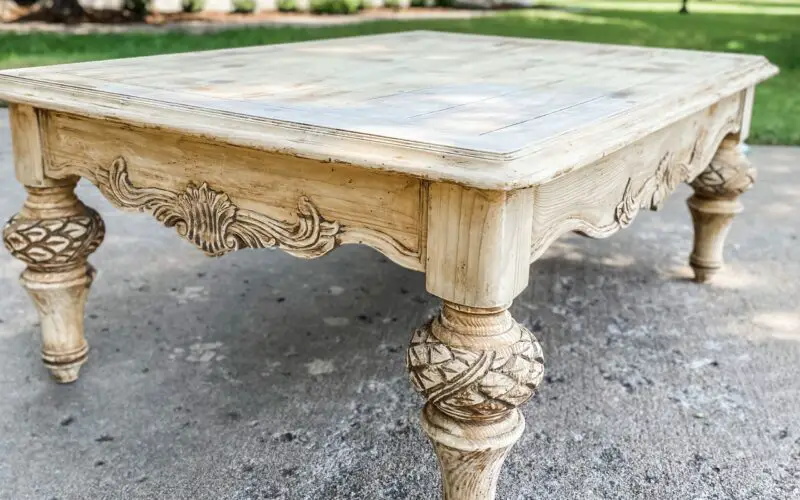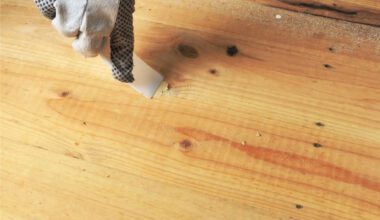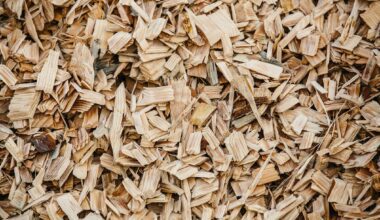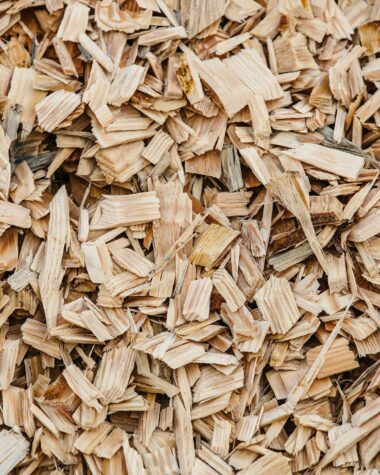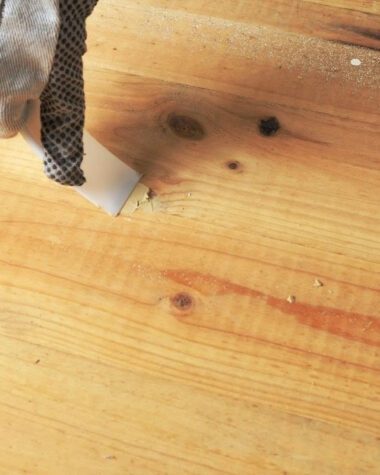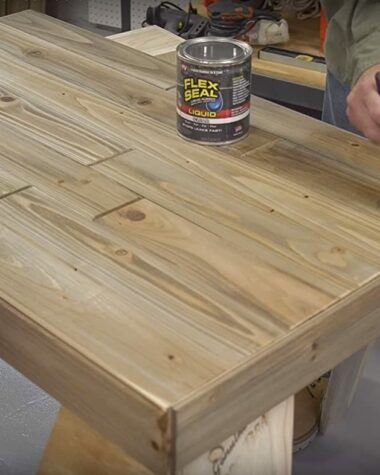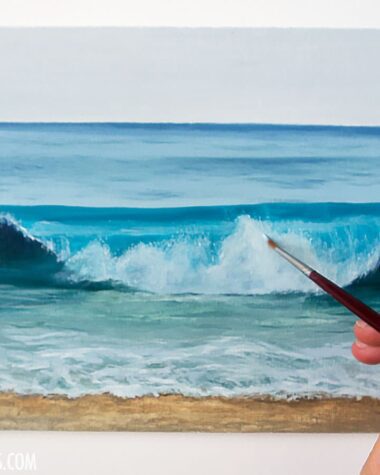Bleach is a very effective and efficient homemade cleaner. Many use bleach as a cleaning agent to remove unwanted stains, to lighten the natural color, and to prevent the darkening effects of aging.
You can actually bleach wood furniture, floors, and walls. Bleaching wooden planks is also done before you use these to construct furniture and more. Here is a guide to show you all about bleaching and how it is properly done.
Types of Wood Bleach
Household chlorine bleach, two-part bleach, and oxalic acid are the three main types of bleach that are readily available and safe to use with wood. We’ll examine each one in this section to see what they can do and the best ways to use them.
Household Chlorine Bleach
Sodium hypochlorite (NaOCl) in a 6% solution is the simple form in which chlorine bleach is sold. Although not quite wood bleach, household bleach is routinely used to brighten wood.
According to the American Chemistry Council, common household laundry bleach used to whiten and disinfect laundry is normally either 5.25 percent “standard strength” or 6 percent sodium hypochlorite “ultra-strong.”
Oxalic Acid
When purchased from a store, oxalic acid is a natural and organic substance that must be diluted with hot water before use. It shows in a crystalline form. Thus, you must handle this product according to the safety instructions in the product because it contains a powerful acid.
Oxalic acid does not modify the color of the wood itself, but it works great at removing stains and returning your wood to its natural form. You must adhere to the cleanup and disposal recommendations in addition to safety precautions.
Two-Part Bleach
Two-part bleach, as the name suggests, consists of two parts that must be blended either before application or on the wood itself by applying one component right after the other.
Sodium hydroxide (NaOH), often known as caustic soda or lye, is the initial component whereas Hydrogen Peroxide (H2O2) is the second element. When combined, they immediately react to produce sodium peroxide (Na2O2), a potent oxidizer.
It’s critical to carefully read the instructions on the container because this reaction can be rather hazardous. If the directions call for it, only combine the two ingredients before applying. If premixed, the solution must be used right away because the bleaching power quickly degrades.
Considerations for Using Wood Bleach
When handled properly, bleach is generally safe to use on wood, especially when you use peroxide. It oxidizes, making wood bleach safe to use. Also, you may use vinegar to neutralize the wood after using bleach.
Wood Bleach Application
Bleaching wood involves several steps. Thus, you must follow these steps to ensure even and well-bleached wood that will suit different projects. For this procedure, you will need to prepare the following:
- Protective gear (gloves, goggles, and mask)
- Varnish or stain remover
- Bleaching solution
- Vinegar
- Water
- Sandpaper 320 to 400 – grit
- Finish
- Rags
Step 1. Wood Preparation
Wash wood thoroughly using regular dishwashing soap and water. Let this dry for at least a day after rinsing and wiping with a clean and soft towel.
Note: Always work in a well-ventilated area when bleaching wood because the chemical bleach can emit dangerous fumes, making you dizzy and even pass out. It is recommended to work on it outdoors.
Using a rag or brush, apply varnish or stain remover to the surface you want to stain. Paint or finishes can be removed with varnish or stain remover. Before bleaching, the area needs to be clean. You should always read the instructions on the packaging before using a varnish or stain remover because the applications may differ depending on the type.
After a few minutes (or as directed on the label), let it sit in the area for a little while before rinsing it off with water. After applying a varnish or stain remover, allow the wood to dry for a day or two.
Step 2. Use A Two-Part Chemical System
A two-part chemical bleach is less aggressive and will change the appearance of wood without affecting its grain or overall character.
Mix the two bleaches. Please, refer to the package instructions for the manufacturer’s directions. Usually, equal parts of the two bleaches are used and mixed in a glass or plastic container. Do not use metal because chemical bleaches can damage the metal.
Apply the bleach evenly by dipping a clean sponge in the solution. This process will saturate the mixture so you can apply it evenly on the wood. Use slow, steady motions to apply bleach. Keep applying until the entire surface is covered in bleach.
Step 3. Neutralize The Bleach
Neutralize the bleach using equal parts of white vinegar and water. After the two-part bleach, mix a solution of half white vinegar and half water. Use a clean sponge on the wood like the bleach was applied.
After applying the neutralizer:
- Rinse the wood with water.
- Use a clean sponge dipped in clean water to wipe down the area.
- Repeat this until the water runs clear.
- Ensure that all the residue and traces of bleach and vinegar have been removed before proceeding with the next steps.
Step 4. Let The Wood Dry
Let the wood dry completely. Drying times differ according to the type of wood and the bleach you use. Check out the manufacturer’s instructions on how long it takes to dry wood after bleaching. Usually, this is stated on the product label. Do not work with the wood until it’s completely dry to the touch.
Use sandpaper with grit 320 and 400 as soon as the wood is completely dry. This will smooth out any rough surfaces and remove rough grains.
After sanding, remove all residue and debris with a damp towel. Neutralize your wood again after sanding the wood and repeat the neutralizing process. Make another mixture of a half and half mixture of white vinegar and water and apply it to the wood.
Rinse with water after you apply vinegar and water solution. Dry the piece once more.
Apply the finish to protect the surface of the wood and enhance its appearance. After your wood has dried, apply the finish. Follow package instructions carefully.
Bonus Tips for Bleaching Wood
Common household chlorine or laundry bleach effectively removes dye color or stain from wood, but it won’t affect the natural color of the wood.
Meanwhile, the “two-part bleach” or peroxide-based bleaches are sodium hydroxide and hydrogen peroxide. When these two are combined, a chemical reaction happens, creating a bleach that blanches the stain color and alters the color of the wood.
Oxalic acid can lessen the graying effect of weather-exposed wood and remove rust, water, and teak stains. Because oxalic acid is extremely poisonous and its crystal form can result in lung hemorrhage when inhaled, using “two-part bleach” is preferable for safer procedures.
Bleach can corrode metal, so never pour it into a container made of metal. Use bleach-filled ceramic or glass dishes instead. Sanitize the wood. Use mineral spirits on a soft, clean rag to clean the wood surface, or use clean water. After that, use a dry cloth to clean every surface. Before bleaching, let the surface thoroughly dry for a day or two.
Takeaways
Remember the facts you learned about wood bleaching in this article. Bleaching wood is a good way to lighten dark-colored wood furniture, flooring or walls. It takes several stages and must be followed closely to ensure success. Lastly, you must choose the right materials and products to efficiently bleach wood.
